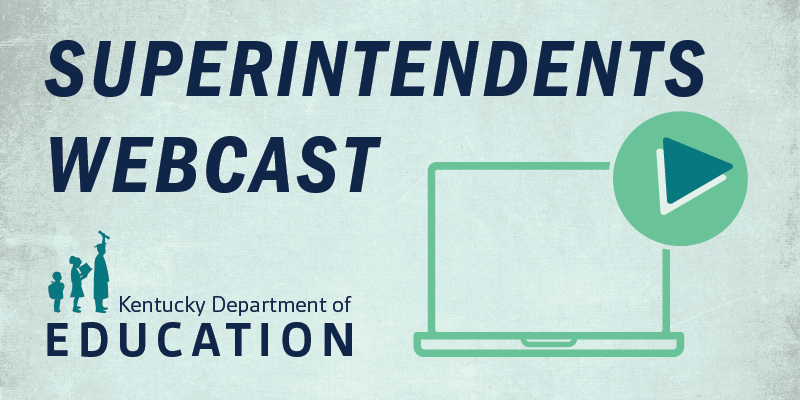
Kentucky’s superintendents and district finance officers received more information on requirements their districts must meet to receive the latest funding from the American Rescue Plan Elementary and Secondary School Emergency Relief Fund (ARP ESSER) during a Finance Officer Webcast on July 15.
Kentucky was awarded over $2 billion in the third round of ESSER funding.
Kelly Foster, associate commissioner of the Kentucky Department of Education’s (KDE’s) Office of Continuous Improvement and Support, said districts should have their Safe Return to In-person Instruction and Continuity of Services Plan posted to their district’s website by July 31. This plan outlines how the district will seek to promote the health and safety of students and continue to provide high-quality services to students in the case Kentucky experiences a resurgence of the COVID-19 virus. Foster said this plan can be a continuation of districts’ existing re-opening plans they created during the 2020-2021 school year.
ARP ESSER Local Education Agency (LEA) Plans, which outline how the district will use its ESSER funds, must be submitted to KDE by July 31.
In accordance with information from the U.S. Department of Education (USED), each district also will be required to submit an ARP ESSER plan to KDE to review for completion and compliance with the ARP ESSER program.
The plan must include a discussion of:
- The extent to which and how funds will be used to implement prevention and mitigation strategies consistent with Centers for Disease Control and Prevention guidance on reopening schools;
- How the LEA will use funds to address the academic impact of lost instruction time through the implementation of evidence-based interventions;
- How the LEA will spend the remainder of its funds;
- How the LEA will ensure that interventions address the academic impact of lost instructional time and respond to the academic, social, emotional and mental health needs of all students; and
- Additionally, plans must include relevant citations for each evidence based practice listed in the plan, a description of how the district conducted meaningful consultation with the required stakeholders and how they took stakeholder feedback into account when crafting the plan.
ARP ESSER Plans must be submitted to kdearpesser@education.ky.gov by 5 p.m. ET on July 31. Questions on the ARP ESSER plans can be directed to Matthew Courtney.
Districts also need to complete a spending plan and assurance document through the Grants Management Application and Planning (GMAP) system by Aug. 31. This is a KDE requirement that districts must complete to properly access and track their ARP ESSER funds. The assurances include a listing of the required actions a district must implement throughout the life of the grant. The spending plan includes a detailed budget.
Maintenance of Equity
Jessica Carlton, assistant director in KDE’s Division of District Support, explained how to meet ARP’s requirement of state- and district-level maintenance of equity.
At the state-level, maintenance of equity is determined by examining state funds provided to the state’s highest-poverty LEAs and high-need LEAs. At the district-level, high-poverty schools must consider two factors: a spending test and a staffing test. In the 2022 and 2023 fiscal years (FY22 and FY23), an LEA must maintain fiscal equity and full-time equivalent (FTE) staff equity at these high-poverty schools as a condition of receiving ARP ESSER funds.
High-poverty schools are identified by the number of students qualifying for free and reduced-price meals. This data can be determined on a district-wide basis or by grade span, such as elementary, middle or high school.
“When you take all of your schools and you rank them highest to lowest based on that free and reduced lunch student count, we’re looking at the top 25%,” said Carlton.
To maintain fiscal equity, an LEA may not, in FY22 or FY23, reduce per-pupil funding in high-poverty schools by an amount that exceeds the total reduction of per-pupil funding for all schools served by that district. When maintaining fiscal equity, an LEA should include all sources of state and local funds available for current expenditures.
Districts must maintain staffing equity in all high-poverty schools and must not reduce the number of FTE staff per pupil by an amount that exceeds the total reduction of FTE staff per-pupil in all schools in the LEA.
“This is all staff: instructional, noninstructional, contract staff and staff that may split their time between schools,” said Carlton.
Exemptions to the maintenance of equity requirement include LEAs that:
- Have a total enrollment of less than 1,000 students;
- Operate a single school;
- Serve all students within each grade span with a single school; and
- Demonstrate an exceptional or uncontrollable circumstance, such as unpredictable changes in student enrollment or a precipitous decline in the financial resources of the LEA as determined by the USED.
Districts can find more information on the MOEquity FAQs document and questions on maintenance of equity can be emailed to Jessica Carlton.




Leave A Comment